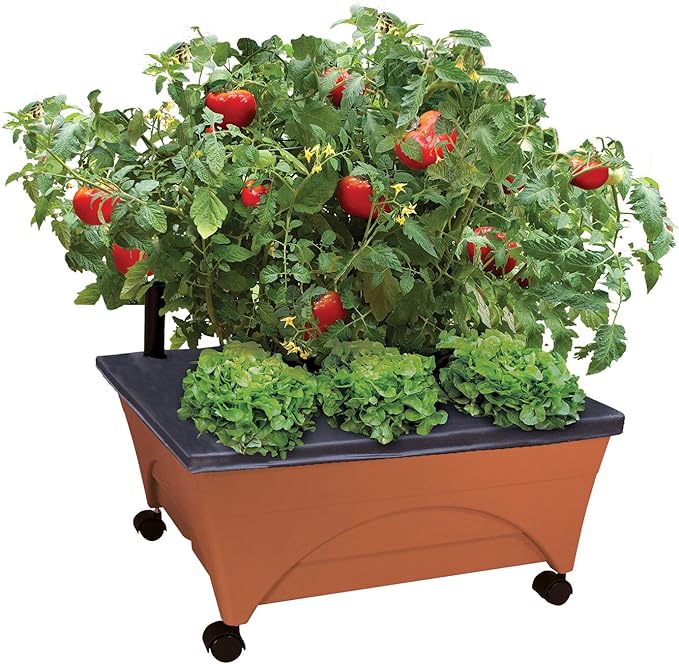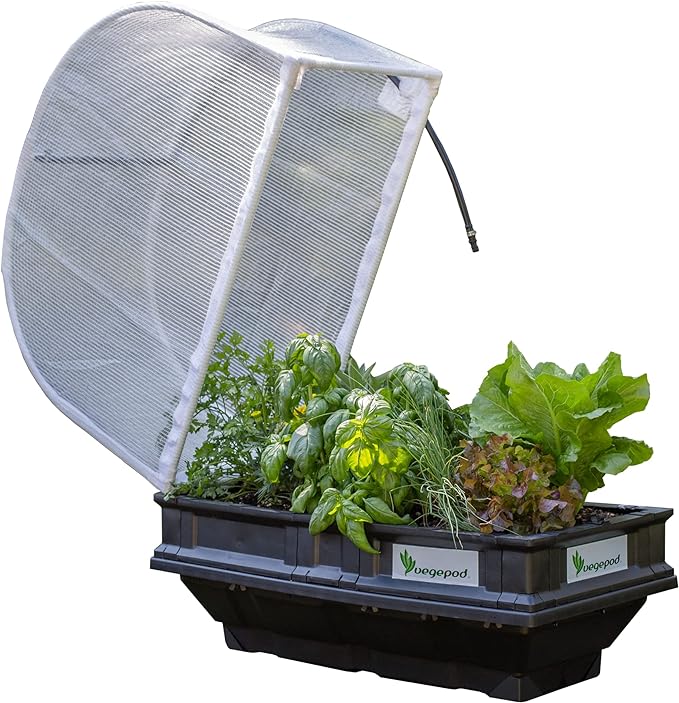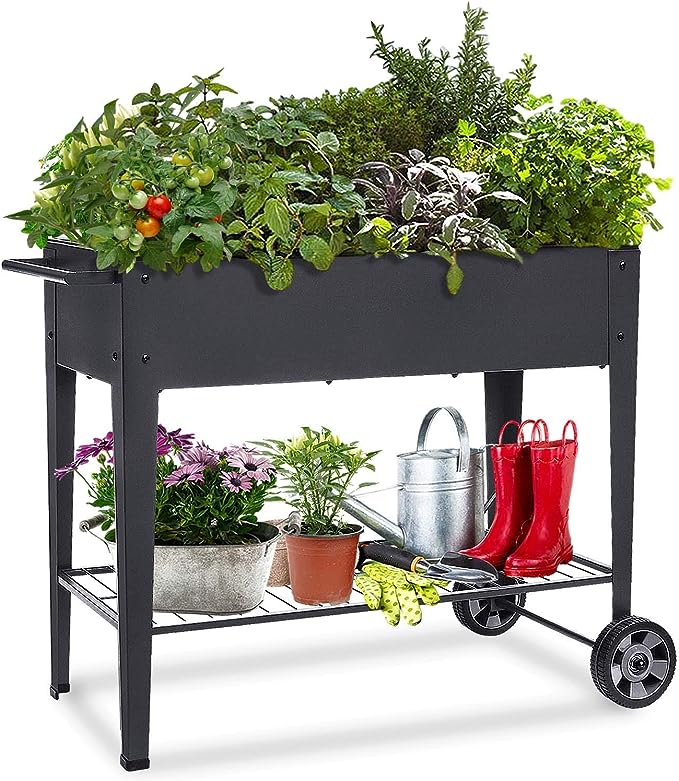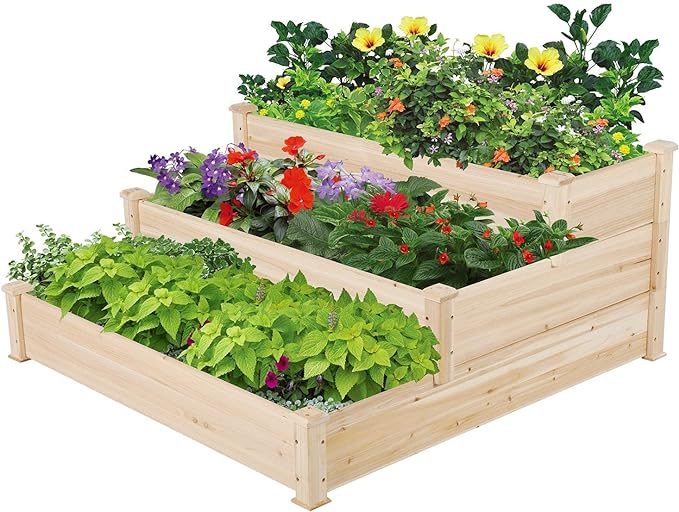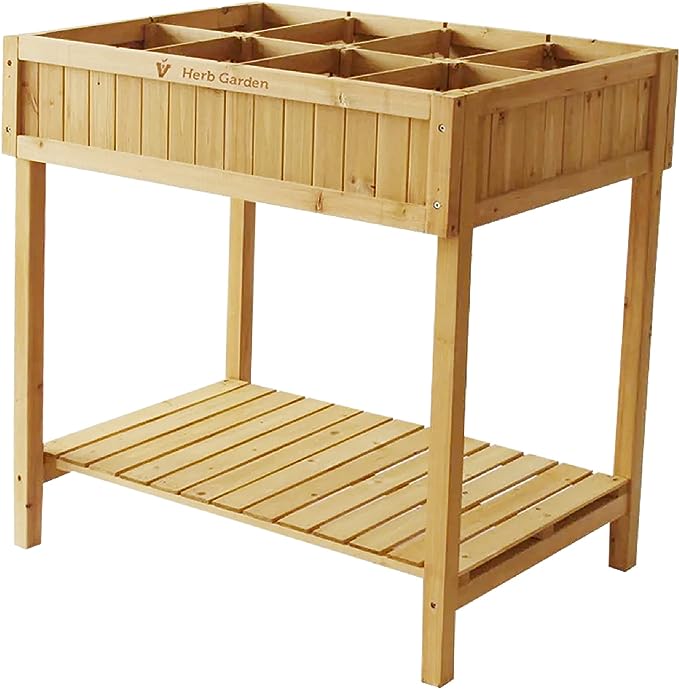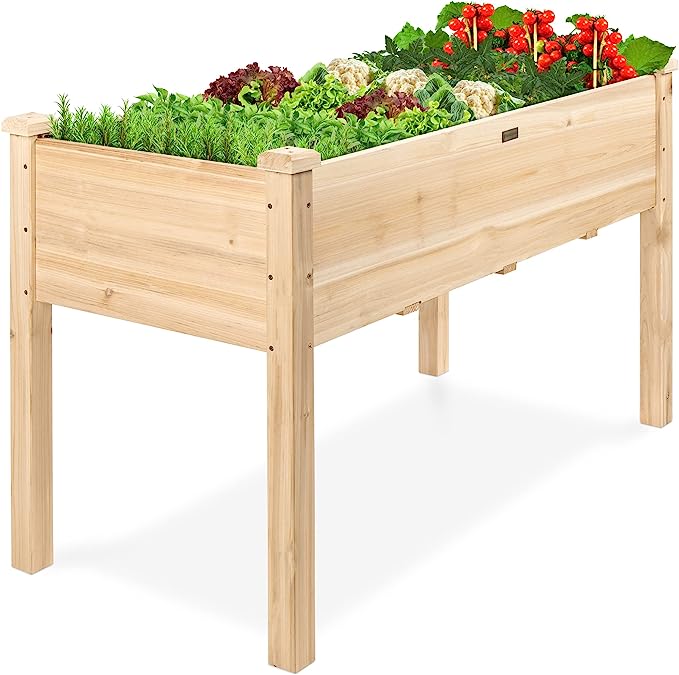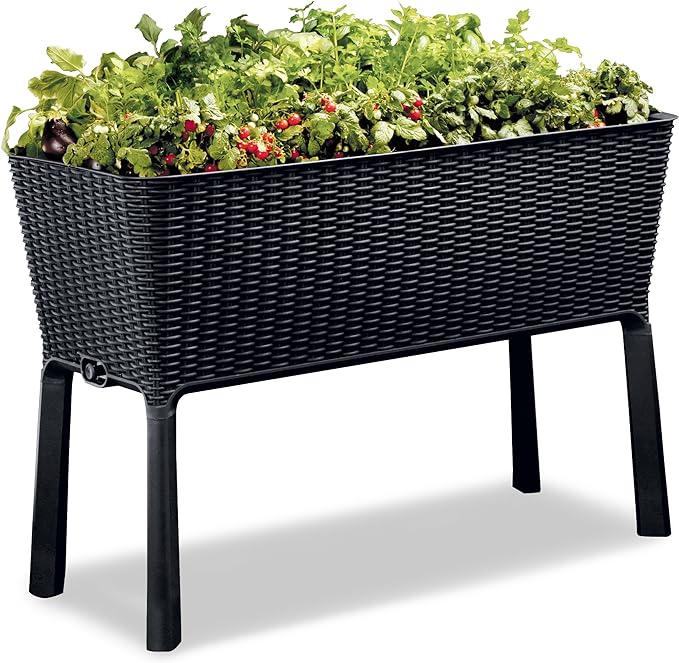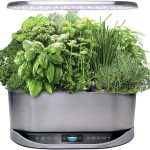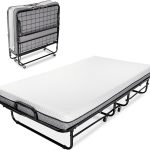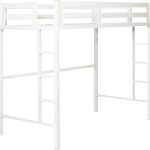Imagine strolling through your backyard on a warm summer morning, surrounded by vibrant flowers and lush greenery, the sweet aroma of fresh herbs wafting through the air. As you plan your dream garden, you’re likely wondering which raised garden bed will help you achieve this picturesque scene. With so many options available, it can be overwhelming. But don’t worry, rest assured that we’ll guide you through the process. We’ve curated a list of the 9 best raised garden beds to help you grow a bountiful harvest. From space-saving designs to durable and long-lasting options, we’ll explore the top picks to elevate your gardening game – but first, let’s get started with the top contender.
Contents
- City Picker Raised Bed Grow Box
- Vegepod Raised Garden Bed Kit
- FOYUEE Raised Planter Box Outdoor Elevated Garden Bed
- Land Guard Galvanized Raised Garden Bed Kit
- Yaheetech 3 Tier Raised Garden Bed
- VegTrug 8 Pocket Herb Garden
- Best Choice Products Raised Garden Bed
- Sunnydaze Hexagon Galvanized Steel Raised Garden Bed Kit
- Keter Easy Raised Garden Bed with Self Watering Planter
- Factors to Consider When Choosing Raised Garden Beds
- Frequently Asked Questions
- Conclusion
City Picker Raised Bed Grow Box
If you’re a city dweller with limited outdoor space, the City Picker Raised Bed Grow Box is an ideal choice, offering a mobile and self-watering unit that can thrive on patios, apartments, or fire escapes.
This innovative grow box is designed to make gardening a breeze, even in the smallest of spaces.
Made of UV-protected resin, it’s built to last and can withstand the elements.
With its self-watering system and aeration screen, you can enjoy faster plant growth and healthier roots.
The space-saving design makes it perfect for decks, balconies, or fire escapes, and the casters allow you to easily move it to track the sun.
Get ready to harvest a bountiful crop with the City Picker Raised Bed Grow Box.
Best For: City dwellers with limited outdoor space who want to grow their own plants and herbs in a small, self-sustaining unit.
Pros:
- Mobile and self-watering unit with casters for easy transport and sun tracking
- Aeration screen enhances oxygen flow to plant roots, promoting faster growth
- Space-saving design for small spaces, such as decks, balconies, or fire escapes
Cons:
- May require special potting mix and dolomite for optimal results
- Limited capacity of 1.5 cubic feet may not be suitable for large-scale gardening
- Weight of 5.5 pounds may be difficult for some users to move around
Vegepod Raised Garden Bed Kit
The Vegepod Raised Garden Bed Kit is an ideal choice for busy gardeners who want to grow their favorite vegetables and plants with minimal maintenance.
With its self-watering system and protective cover, this kit makes gardening easy and convenient.
The modular design makes assembly and disassembly a breeze, and you can elevate the bed to 39.4 inches with the Vegepod Stand, giving you more flexibility.
With a 10-year warranty, you can trust that this kit will last.
The protective cover shields your plants from harsh sun, bugs, and animals, and the self-watering system reduces watering frequency.
You’ll find it’s easy to use and maintain, making it perfect for small spaces like balconies, patios, or indoor areas.
Best For: Busy gardeners who want to grow their favorite vegetables and plants with minimal maintenance.
Pros:
- Easy to use and maintain, making it perfect for small spaces like balconies, patios, or indoor areas.
- Self-watering system reduces watering frequency, and the protective cover shields plants from harsh sun, bugs, and animals.
- Modular design makes assembly and disassembly a breeze, and the product comes with a 10-year warranty.
Cons:
- Some reviewers mention issues with assembly instructions or minor design flaws.
- Requires some maintenance, such as watering and pruning.
- The product may not be suitable for large-scale gardening due to its compact size.
FOYUEE Raised Planter Box Outdoor Elevated Garden Bed
By elevating your garden to a comfortable 31.5 inches, the FOYUEE Raised Planter Box Outdoor Elevated Garden Bed eliminates the need to bend over, making it the best choice for gardeners who want to avoid straining their backs.
You’ll appreciate the ergonomic design, which allows you to tend to your plants without breaking a sweat.
This galvanized steel planter box is built to last, with an anti-rusty coating that protects it from the elements.
With a spacious 2.5 cubic feet of soil capacity, you can grow a variety of vegetables, herbs, and flowers.
Plus, the drainage hole and line prevent waterlogging, and the handy shelf holds your gardening accessories within reach.
Best For: gardeners who want to avoid straining their backs while tending to their plants, and those who need a convenient and portable gardening solution.
Pros:
- Ergonomic design eliminates the need to bend over, making it convenient for gardeners of all ages and abilities
- Spacious 2.5 cubic feet of soil capacity allows for a variety of vegetables, herbs, and flowers to be grown
- Portable and easy to move to anywhere, with a handy shelf for holding gardening accessories
Cons:
- Some customers have mentioned that the instructions for assembly are not clear
- Made of metal, which may not be as aesthetically pleasing as a wooden planter box
- No additional features or customization options are available
Land Guard Galvanized Raised Garden Bed Kit
When you’re looking for a spacious and durable raised garden bed to grow a variety of vegetables, the Land Guard Galvanized Raised Garden Bed Kit is an excellent choice, offering 7.14 cubic feet of capacity in its 48D x 24W x 12H inches oval planter.
This metal planter is made of silver-colored, galvanized metal that’s designed to withstand outdoor conditions.
With its easy-to-assemble design, you’ll have it set up in about 5 minutes.
The open base prevents water from accumulating, and the double-layer anti-corrosion galvanizing and oval structure design provide added durability.
Plus, the sturdy construction and reusable design make it a great value for the price.
Best For: Gardeners looking for a spacious, durable, and easy-to-assemble raised garden bed for growing a variety of vegetables.
Pros:
- Easy to assemble, taking about 5 minutes to set up
- Sturdy construction, durable, and reusable
- Open base design prevents water accumulation and decay
Cons:
- Some customers have reported missing parts
- Poor customer service has been reported by some customers
- Thin metal has been a complaint from some users
Yaheetech 3 Tier Raised Garden Bed
If you’re looking for a spacious and versatile raised garden bed, the Yaheetech 3 Tier Raised Garden Bed is an excellent choice, offering ample space for soil and plants to promote healthy growth.
Made from natural fir wood, this bed is well-sanded for safe use and features 0.6 thick solid wood boards fixed with metal hardware for long-term durability.
You’ll appreciate the 3-tier design, which can be easily transformed into three separate growing beds.
With a modern style and rectangular shape, this bed is perfect for cultivating plants like vegetables, flowers, and herbs.
Measuring 47.2D x 47.2W x 22H, it’s compact enough for small spaces, yet spacious enough to yield a bountiful harvest.
Best For: Gardeners who want a spacious and versatile raised garden bed for cultivating vegetables, flowers, and herbs.
Pros:
- Ample space for soil and plants, promoting healthy growth
- Sturdy structure with 0.6 thick solid wood boards fixed with metal hardware for long-term durability
- 3-tier design allows for transformation into three separate growing beds
Cons:
- Wood may be fragile and prone to scratches
- Some reviewers mentioned difficulty with assembly
- No explicit warranty information is provided
VegTrug 8 Pocket Herb Garden
The VegTrug 8 Pocket Herb Garden is an ideal choice for those seeking a convenient and organized way to grow a variety of herbs in a small outdoor space.
With its spacious 8 pockets and lower shelf for tool storage, this planter offers ample space for your herbs and gardening tools.
The planter is made from 100% FSC plantation cedar wood, guaranteeing a long-lasting and sturdy structure.
The lower shelf provides ample space for storing your gardening tools, keeping them within easy reach.
With a comfortable working height of 80 cm, you won’t have to worry about crouching or straining your back while tending to your herbs.
Overall, this herb garden is a great option for anyone looking to grow their favorite herbs in a compact, well-organized space.
Best For: Gardeners with small outdoor spaces who want to grow a variety of herbs in a convenient and organized way.
Pros:
- Durable and sturdy construction made from 100% FSC plantation cedar wood
- Spacious pockets provide well-aerated space for herbs to grow
- Comfortable working height of 80 cm to avoid crouching or straining your back
Cons:
- Some customers report issues with short screws and flimsy shelves
- May require additional protection such as polyurethane for longevity
- Assembly may require additional tools such as casters for easy movement
Best Choice Products Raised Garden Bed
For gardeners seeking ample growing space and reduced strain on their back and knees, the Best Choice Products Raised Garden Bed is an ideal choice, offering a spacious 5CuFt planting area and an ergonomic 30-inch tall design.
You’ll appreciate the proper drainage system that prevents waterlogging and mineral buildup, allowing your plants to receive the right amount of moisture.
The raised bed’s cedar wood construction and weather-resistant finish promote durability, while the included liner separates the wood from the soil, preventing weeds and animal interference.
With a weight capacity of 200 lbs, you can plant a variety of herbs, vegetables, and flowers, and the compact 24D x 48W x 30H dimensions fit perfectly in small backyards or patios.
Best For: gardeners seeking ample growing space and reduced strain on their back and knees.
Pros:
- Provides a spacious 5CuFt planting area for growing a variety of plants
- Ergonomic 30-inch tall design reduces strain on back and knees
- Proper drainage system prevents waterlogging and mineral buildup, promoting healthy plant growth
Cons:
- Material seems lightweight and may deteriorate over time
- May require two people to assemble
- No explicit warranty information available
Sunnydaze Hexagon Galvanized Steel Raised Garden Bed Kit
The Sunnydaze Hexagon Galvanized Steel Raised Garden Bed Kit is an ideal choice for gardeners seeking a low-maintenance, high-quality outdoor planter.
This kit comes with everything you need to get started, including hardware and tools for effortless assembly.
The corrugated rectangular galvanized steel material supports a sturdy frame that promotes healthy root growth.
With a capacity of 80 gallons, this hexagonal planter provides ample space for your plants to thrive.
Measuring 36 inches wide, 40 inches long, and 16 inches tall, it’s perfect for small to medium-sized gardens.
Weighing only 18 pounds, it’s lightweight and easy to move around.
Best For: Gardeners seeking a low-maintenance, high-quality outdoor planter for small to medium-sized gardens.
Pros:
- Easy to assemble with included hardware and tools
- Durable construction with corrugated rectangular galvanized steel material
- Promotes healthy root growth with raised bed brackets
Cons:
- Some customers reported difficulty with assembly due to misaligned holes
- May require longer screws or different fastener method for added stability
- A few customers reported receiving damaged or defective products
Keter Easy Raised Garden Bed with Self Watering Planter
The Keter Easy Raised Garden Bed with Self Watering Planter is an excellent choice for those looking for a low-maintenance gardening solution that accommodates people with disabilities or mobility issues, thanks to its ergonomic design and easy drainage system.
This 44.9′ x 19.4′ x 29.8′ raised bed features a self-watering system, ensuring your plants receive the right amount of moisture. A water gauge indicates when your plants need more water, and the easy drainage system prevents root decay and overwatering.
With a capacity of 31.7 gallons, you can plant a variety of vegetables, herbs, or flowers. The graphite-colored planter is made of durable plastic and is easy to assemble with the included instruction manual.
Plus, it’s lightweight, weighing only 29.6 pounds, making it easy to move around your outdoor space.
Best For: People with disabilities, mobility issues, or those who want a low-maintenance gardening solution.
Pros:
- Ergonomic design for ease of use by those with disabilities and the young at heart
- Self-watering system with a water gauge to ensure plants receive the right amount of moisture
- Easy drainage system prevents root decay and overwatering
Cons:
- Assembly is required, which may be a challenge for some users
- No information is available on warranty and support
- Only one negative review was found among the customer reviews
Factors to Consider When Choosing Raised Garden Beds
When choosing a raised garden bed, you’ll want to guarantee several key factors to verify you get the one that’s right for you.
You’ll need to ponder the material it’s made of, the space you have available, and how easy it’s to move around.
From there, you can start thinking about the nitty-gritty details like watering, drainage, and aeration.
Material Selection
Your raised garden bed’s material selection is crucial, as it directly impacts the longevity and maintenance requirements of your garden.
When choosing a material, factor in durability, as some materials like wood can rot or decay over time, while others like metal or plastic can last longer with minimal upkeep.
If you opt for wooden raised beds, look for sustainable sources like recycled plastic lumber or FSC-certified wood for an eco-friendly option.
Metal raised beds, such as those made from galvanized steel, are lightweight and corrosion-resistant, but may require additional coating for rust protection.
Plastic raised beds are often inexpensive and low-maintenance, but may not be as aesthetically pleasing as other materials and can degrade over time.
Don’t forget to take into account the weight capacity and strength of the material, as well as its ability to withstand outdoor weather conditions and support the weight of soil and plants.
Space and Layout
With your material selected, you can now turn your attention to configuring the space and layout of your raised garden bed to maximize its potential.
Think about the overall size of your bed and how it will fit within your available yard space. Ponder the accessibility of your bed – do you want it to be narrow and long, or shorter and wider? A narrower bed allows for easier reach to the center, while a wider bed provides more growing space.
You’ll also want to reflect on the pathways between beds, ensuring they’re wide enough for comfortable walking and working.
Next, think about the internal layout of your bed. Will you use a grid system, with neat rows and columns, or a more free-form design?
Contemplate the mature size of your plants and leave enough space between them for proper growth and air circulation. Don’t forget to include space for companion planting, where certain plants are paired to enhance growth or deter pests.
Mobility and Portability
Consider incorporating mobility and portability into your raised garden bed design to give yourself the flexibility to optimize sun exposure and accessibility as needed. This feature is especially important if you have a yard with limited sunlight or if you plan to rearrange your outdoor space in the future.
When shopping for a raised garden bed, look for one with casters or wheels for easy relocation. A lightweight and compact design will also make it easier to move the bed around your yard or patio.
If you plan to move the bed frequently, consider a durable and rust-resistant material, such as galvanized steel or recycled plastic, to withstand regular relocation. Elevated beds with a lower center of gravity are also a great option as they’re less likely to tip over when moved, providing added stability and safety.
Ultimately, a self-contained and compact raised bed can be easily relocated to different areas of your yard or even taken to a new home if needed. By considering mobility and portability, you’ll have the freedom to adjust your garden’s layout as needed, ensuring a bountiful harvest for years to come.
Watering and Drainage
When it comes to watering and drainage, a well-designed raised garden bed can make all the difference between a thriving harvest and a crop failure.
You’ll want to think carefully about the type of material used to construct the bed, as metal and plastic beds often have built-in drainage holes, while wood and composite beds may require additional measures.
The depth of the bed is also vital, as deeper beds allow for better water penetration and aeration of the soil.
Look for raised beds with built-in watering systems, such as self-watering planters, which can reduce the frequency of watering and prevent overwatering.
Some beds even come with a water gauge or indicator to help you monitor the soil moisture level.
A good drainage system is essential to prevent waterlogged soil, which can lead to root rot and other plant diseases.
By choosing a raised bed with a well-designed drainage system, you’ll be able to enjoy a healthy and thriving harvest.
Aeration and Ventilation
As you select a raised garden bed, you’ll want to prioritize aeration and ventilation to create an environment that fosters healthy root growth and prevents waterlogging.
Adequate aeration and ventilation are essential for promoting healthy root growth by allowing oxygen to reach plant roots and preventing waterlogging, which can lead to root rot and other diseases.
A well-designed raised bed should have a minimum of 1-2 inches of space between the soil surface and the top of the bed to allow for air circulation and prevent moisture buildup.
Incorporating materials like perlite, vermiculite, or sand into the soil mix can improve aeration and drainage, reducing the risk of waterlogged soil.
Some raised beds come with built-in aeration systems, such as ventilation tubes or mesh panels, which can provide additional oxygen to plant roots and improve overall soil health.
Proper aeration and ventilation can also help regulate soil temperature, reducing the risk of overheating and promoting ideal microbial activity.
Pest and Weed Control
You’ll want to think carefully about pest and weed control when selecting a raised garden bed, since these issues can quickly undermine the health and productivity of your garden.
To minimize weed growth, consider a raised bed with a built-in physical barrier, such as landscaping fabric or plastic liners, which can block light and prevent seed germination.
Adding a 2-3 inch layer of organic mulch, like wood chips or straw, can also help suppress weeds and retain moisture in the soil.
When it comes to pests, look for raised beds with built-in pest control features, such as copper edging, which can deter pests like slugs and snails.
Another effective approach is to incorporate companion planting, where certain plants are paired to deter pests.
By considering these factors, you can create a pest- and weed-free environment that allows your plants to thrive.
Ease of Assembly
With a few simple considerations, you can find a raised garden bed that’s a snap to assemble, even if you’re not a DIY expert.
Look for raised beds that come with easy-to-follow instructions and don’t require special tools or expertise.
Some models feature pre-drilled holes and labeled parts, making assembly a quick 20-30 minute task.
Snap-together or interlocking designs eliminate the need for screws or nails, making assembly a breeze.
Opt for raised beds with fewer pieces and parts to reduce the likelihood of errors and speed up the assembly process.
Keep in mind that larger or heavier models may require two people for assembly, so consider the level of assistance you may need.
Budget and Value
When setting a budget for a raised garden bed, consider that prices can vary wildly, ranging from under $50 to over $500, depending on the material, size, and features.
You’ll want to evaluate the value of a raised garden bed by considering factors such as durability, ease of assembly, and functionality. Don’t assume that a higher-priced option is always the best value – some lower-priced options may offer similar quality and performance.
To get the most bang for your buck, calculate the cost per square foot of growing space. This will help you compare different options and guarantee you’re getting the best value.
Be cautious of extremely low prices, as they may indicate a lower quality product that won’t provide the desired results or last long.
Frequently Asked Questions
Can I Use Raised Garden Beds on a Balcony or Patio?
You can definitely use raised garden beds on a balcony or patio, as long as they’re compact and lightweight, and you guarantee proper drainage and weight distribution to avoid damaging the surface.
How Often Should I Water My Raised Garden Bed Plants?
“As you tenderly nurture your raised garden bed, imagine the parched soil drinking in the water like a thirsty traveler at an oasis. You should water your plants when the top 2-3 inches of soil feel dry to the touch, usually every 2-3 days in warm weather.”
Are Raised Garden Beds Suitable for People With Mobility Issues?
You’ll be relieved to know that raised garden beds are perfect for people with mobility issues, as they’re waist-high, reducing strain on your back and knees, and allowing you to garden comfortably while seated or standing.
Can I Grow Vegetables in a Shaded Raised Garden Bed?
You can grow veggies in a shaded raised bed, but you’ll need to choose shade-tolerant varieties like leafy greens, herbs, or mushrooms. Partial shade can still yield a decent harvest, but be prepared for slower growth.
Do Raised Garden Beds Attract Pests or Wildlife?
As you tend to your lush oasis, you wonder if raised beds become a magnet for unwanted visitors. Unfortunately, yes, they can attract pests and wildlife, especially if you’re growing their favorite snacks, like juicy veggies or sweet fruits.
Conclusion
You’ve made it to the end of our roundup of the 9 best raised garden beds for a bountiful harvest!
As you start planning your garden, remember that 90% of households in the United States participate in some form of gardening, making it a popular hobby that brings people together.
Now, get ready to dig in and watch your garden thrive!
